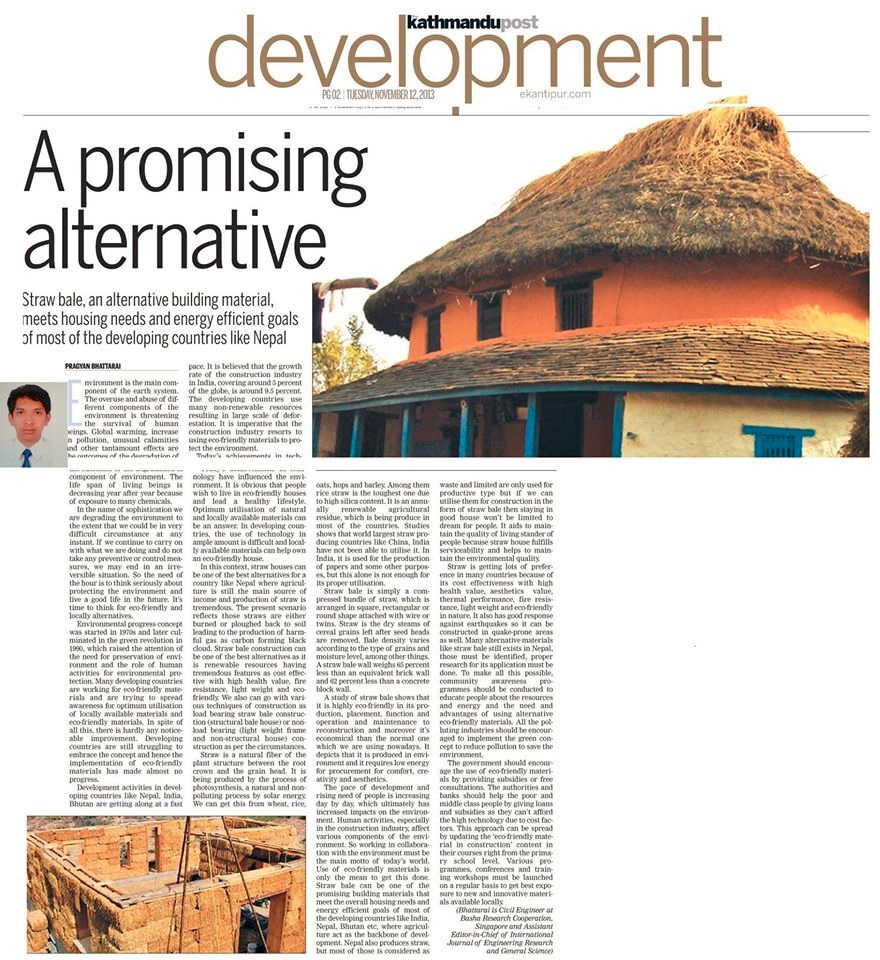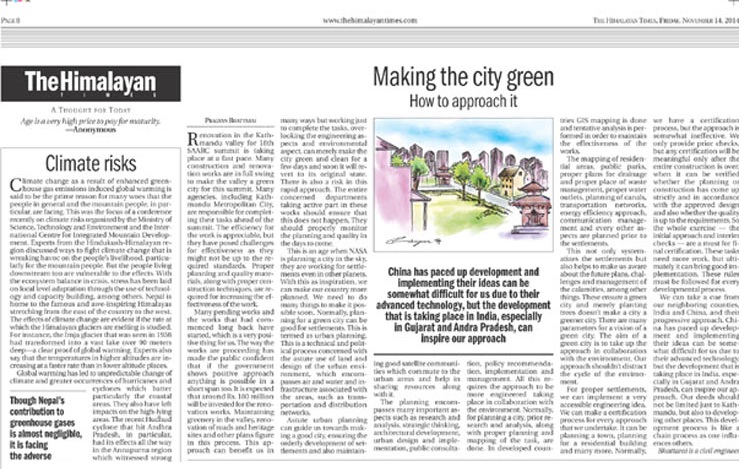A promising Alternative- Straw House
Straw Bale an alternative building material meets housing needs and energy efficient goals of most of the developing countries like Nepal.
The environment is a crucial component of the Earth's system. Human overuse and abuse of various environmental components are threatening the survival of humanity on this planet. Global warming, increased pollution, unusual natural disasters, and other related effects are direct outcomes of environmental degradation. The lifespan of living beings is decreasing annually due to exposure to numerous harmful chemicals. In the quest for sophistication, we are degrading the environment to the extent that we could face severe consequences at any moment. If we continue these activities without implementing preventive or control measures, we may find ourselves in an irreversible situation. It is imperative to seriously consider protecting the environment to ensure a sustainable and high-quality lifestyle in the future.
We must explore alternative, eco-friendly, and locally available materials. The concept of environmental progress began in the 1970s and culminated in the Green Revolution of the 1990s, which highlighted the need for environmental preservation and the role of human activities in environmental protection. Many developing countries are working towards using eco-friendly materials and spreading awareness about the optimal utilization of locally available resources. Despite these efforts, noticeable improvements remain elusive. Developing countries continue to struggle with implementing eco-friendly materials effectively.
Developmental activities in countries like Nepal, India, and Bhutan are advancing rapidly. For instance, the growth rate of the construction industry in India, which accounts for about 5% of global activity, is approximately 9.5%. It is widely recognized that current construction practices in the developing world rely heavily on non-renewable resources, leading to large-scale deforestation with minimal regard for environmental protection. It is crucial for the construction industry to adopt eco-friendly materials to mitigate environmental impact.
Technological advancements have profoundly influenced the environment. People increasingly desire eco-friendly homes that contribute to a clean and green environment, ensuring a healthy lifestyle. Although this presents challenges, utilizing local materials and manpower can address these issues. Optimal use of natural and locally available materials offers a viable solution to these challenges. For developing countries, heavy reliance on technology is challenging; thus, finding and adapting local materials can be an effective way to achieve eco-friendly housing.
Choosing materials that are locally available, have minimal environmental impact, and are eco-friendly is crucial. The selection process must be tailored to specific needs and circumstances. For example, research in the U.S. suggests that traditional bricks are both uneconomical and environmentally harmful. Bricks, made from topsoil, deplete soil fertility, making it less productive. Alternatives such as fly ash bricks, cement bricks, or bricks from dismantled structures can be more sustainable and environmentally friendly.
In a developing country like Nepal, where agriculture remains a primary source of income and straw production is significant, straw bale construction presents a promising alternative. Straw bales are renewable, cost-effective, and offer high health and aesthetic value, thermal performance, fire resistance, light weight, and eco-friendliness. Currently, straw is either burned or plowed back into the soil, contributing to harmful emissions and air pollution. Utilizing straw for construction can address these issues while promoting sustainable building practices.
Natural resource consumption for modern conveniences has severe environmental drawbacks. Materials that cannot be regenerated, such as marble and granite, should be used wisely. Alternatives like veneer flooring, natural wood flooring, and simple architectural flooring are more sustainable and eco-friendly. Awareness of the long-term effects of material use helps in making informed choices. Reducing the use of volatile organic compounds (VOCs) in construction can prevent various health issues and environmental pitfalls.
The rapid pace of development and increasing human needs are intensifying environmental impacts. Therefore, working in harmony with the environment must be a primary goal. Using eco-friendly materials is a key strategy to achieve this. Straw bale construction can meet the housing and energy efficiency needs of developing countries like India, Nepal, and Bhutan, where agriculture is a cornerstone of development. In Nepal, utilizing straw for construction, rather than considering it waste, could transform housing practices and improve living standards.
Community awareness programs should be conducted to educate people about resource management, energy efficiency, and the benefits of alternative eco-friendly materials. Polluting industries should be encouraged to adopt green practices to reduce pollution and protect the environment. Governments should support the implementation of eco-friendly local materials by providing subsidies and free consultations. Financial institutions should assist low- and middle-income individuals with loans and subsidies to make eco-friendly technology more accessible. This approach should be integrated into educational curricula from an early age. Regular programs, conferences, and training workshops should be organized to keep abreast of innovative and locally sourced materials.
Nepali Version
पारिस्थितिकीय संरक्षण र दिगो निर्माण: आवश्यकता र सम्भावना
पारिस्थितिकी पृथ्वीको प्रणालीको मुख्य घटक हो। मानवले विभिन्न पारिस्थितिकीय घटकहरूको अत्यधिक उपयोग र दुरुपयोग गर्दा पृथ्वीमा मानव जीवनको अस्तित्वलाई खतरामा पार्दैछ। ग्लोबल वार्मिङ, प्रदूषणको वृद्धि, असामान्य प्राकृतिक प्रकोपहरू र अन्य सम्बन्धित प्रभावहरू पारिस्थितिकीको विनाशका परिणाम हुन्। हाम्रा जीवनको अवधि हरेक वर्ष हानिकारक रसायनहरूको संपर्कका कारण घट्दैछ। आधुनिकताका नाममा हामी पारिस्थितिकीलाई यसरी बिगारिरहेका छौं कि कुनै समय हामी गम्भीर समस्यामा परे पनि अचम्मित नहुनु पर्छ। यदि हामी यस्ता क्रियाकलापलाई जारी राख्यौं भने र कुनै रोकथाम वा नियन्त्रणका उपाय अपनाएनौं भने हामी अवसानको अवस्थामा पुग्न सक्छौं। त्यसैले, भविष्यमा राम्रो जीवनशैली सुनिश्चित गर्न पारिस्थितिकीको रक्षा गर्न गम्भीरतासाथ विचार गर्नु आवश्यक छ।
हामीलाई वैकल्पिक, पर्यावरणमैत्री र स्थानीय रूपमा उपलब्ध सामग्रीहरूको खोजी गर्नु आवश्यक छ। पर्यावरणीय प्रगति को अवधारणा १९७० को दशकमा सुरु भयो र १९९० को दशकमा हरित क्रान्तिमा परिणत भएको थियो जसले पर्यावरणको संरक्षणको आवश्यकता र मानव क्रियाकलापहरूको भूमिकालाई उजागर गर्यो। धेरै विकासशील देशहरू पर्यावरणमैत्री सामग्रीहरूको प्रयोग र स्थानीय स्रोतहरूको प्रभावकारी उपयोगको बारेमा जनचेतना फैलाउन काम गरिरहेका छन्। यद्यपि यी प्रयासहरू भइरहेका छन्, यथार्थमा उल्लेखनीय सुधारहरू देख्न सकिएको छैन। विकासशील देशहरूले अझै पर्यावरणमैत्री सामग्रीहरूको प्रभावकारी कार्यान्वयनमा संघर्ष गरिरहेका छन्।
नेपाल, भारत, र भुटान जस्ता देशहरूमा विकासात्मक गतिविधिहरू तीव्र गतिमा अघि बढिरहेका छन्। उदाहरणका लागि, भारतको निर्माण उद्योगको वृद्धि दर, जुन विश्वको लगभग ५% गतिविधिमा आउँछ, करिब ९.५% छ। विकासशील विश्वमा हालका निर्माण अभ्यासहरूले नवीकरणयोग्य स्रोतहरूको अत्यधिक प्रयोग गर्दै जंगल कटानको ठूलो मात्रामा मद्दत पुर्याइरहेका छन् जसले पर्यावरण संरक्षणमा कम ध्यान दिन्छ। यसले पारिस्थितिकीलाई कम गर्नको लागि निर्माण उद्योगले पर्यावरणमैत्री सामग्रीहरूको प्रयोग गर्न अत्यन्त महत्वपूर्ण छ।
प्रविधिकीका उन्नति पारिस्थितिकीय प्रभावमा गहिरो प्रभाव पार्छ। मानिसहरूले बढ्दो रूपमा पारिस्थितिकीमैत्री घरहरू चाहन्छन् जुन सफा र हरियो वातावरणमा योगदान पुर्याउँछन् र स्वस्थ जीवनशैली सुनिश्चित गर्छन्। यद्यपि यो चुनौतीपूर्ण छ, स्थानीय सामग्री र जनशक्ति प्रयोग गर्दा यी समस्याहरूलाई सम्बोधन गर्न सकिन्छ। प्राकृतिक र स्थानीय रूपमा उपलब्ध सामग्रीहरूको प्रभावकारी उपयोगले यी चुनौतीहरूको समाधान गर्न सक्दछ। विकासशील देशहरूको लागि, प्रविधिको अत्यधिक निर्भरता चुनौतीपूर्ण छ; त्यसैले स्थानीय सामग्रीको खोजी र समायोजनले पर्यावरणमैत्री आवास प्राप्त गर्न प्रभावकारी उपाय हुन सक्छ।
स्थानीय रूपमा उपलब्ध, पर्यावरणमा न्यूनतम प्रभाव पर्ने, र पारिस्थितिकीमैत्री सामग्री चयन गर्नु अत्यावश्यक छ। सामग्रीहरूको चयन विशिष्ट आवश्यकताहरू र परिस्थितिहरूसँग मेल गर्नु पर्छ। उदाहरणका लागि, अमेरिकी अनुसन्धानले परम्परागत ईंटलाई असार्गिक र पर्यावरणीय रूपमा हानिकारक सामग्रीको रूपमा सूचीबद्ध गरेको छ। ईंट, जुन माथिल्लो माटोबाट बनाइन्छ, माटोको उर्वरता घटाउँछ जसले यसलाई कम उत्पादनशील बनाउँछ। वैकल्पिक जस्तै फ्लाई आश ईंट, सीमेंट ईंट, वा पुनः निर्माण गरिएका संरचनाहरूको ईंटहरू थप टिकाऊ र पर्यावरणमैत्री हुन सक्छन्।
नेपाल जस्तो विकासशील देशमा, जहाँ कृषि प्रमुख आय स्रोत हो र तिनको उत्पादन उल्लेखनीय छ, स्ट्रा बेल निर्माण एक उत्तम वैकल्पिक हो। स्ट्रा बेलहरू नवीकरणीय, लागत-कुशल, र उच्च स्वास्थ्य र सौन्दर्य मूल्य, थर्मल प्रदर्शन, आगो प्रतिरोध, हल्कापन, र पारिस्थितिकीमैत्री छन्। हालको अवस्थामा, स्ट्रा प्रायः जलेर वा माटोमा फर्काइन्छ जसले हानिकारक उत्सर्जन र हावामा प्रदूषण उत्पन्न गर्छ। स्ट्रा निर्माणको उपयोग गर्दा यी समस्याहरूलाई समाधान गर्न सकिन्छ र दिगो निर्माण अभ्यासलाई प्रवर्द्धन गर्न सकिन्छ।
प्राकृतिक संसाधनहरूको उपयोग आधुनिक सुविधाका लागि पर्यावरणीय समस्याहरू ल्याउँछ। पुनः उत्पन्न गर्न नसकिने सामग्रीहरू जस्तै मर्मर र ग्रेनाइटको प्रयोगमा विवेकपूर्ण हुनु पर्छ। वैकल्पिक सामग्रीहरू जस्तै भिनियर फ्लोरिङ, प्राकृतिक काठको फ्लोरिङ, र साधारण आर्किटेक्चरल फ्लोरिङ बढी दिगो र पर्यावरणमैत्री हुन्। सामग्रीको दीर्घकालिक प्रभावको बारेमा जागरूकता आवश्यक छ जसले सही सामग्री चयनमा मद्दत पुर्याउँछ। निर्माणमा सस्तो भोलाटाइल अर्गानिक कम्पाउण्ड (VOCs) को प्रयोग घटाउनाले विभिन्न स्वास्थ्य समस्याहरू र वातावरणीय समस्याबाट जोगिन सकिन्छ।
विकासको तीव्र गति र बढ्दो मानव आवश्यकताहरूले पर्यावरणीय प्रभावलाई तीव्र पार्दैछन्। त्यसैले, आजको संसारमा पारिस्थितिकीसँग समन्वयमा काम गर्नु प्राथमिक लक्ष्य हुनुपर्छ। पर्यावरणमैत्री सामग्रीहरूको प्रयोग यसलाई प्राप्त गर्नको प्रमुख रणनीति हो। स्ट्रा बेल निर्माणले भारत, नेपाल, भुटान जस्ता विकासशील देशहरूको आवास र ऊर्जा दक्षता आवश्यकताहरूलाई पूरा गर्न सक्छ, जहाँ कृषि विकासको आधार हो। नेपालमा, स्ट्रा निर्माणको उपयोगले आवास अभ्यासलाई रूपान्तरण गर्न र जीवनस्तर सुधार गर्न सक्छ।
समुदायलाई स्रोत व्यवस्थापन, ऊर्जा दक्षता, र वैकल्पिक पर्यावरणमैत्री सामग्रीहरूको फाइदाबारे शिक्षित गर्नको लागि जनचेतना कार्यक्रमहरू सञ्चालन गर्नुपर्छ। प्रदूषणकारी उद्योगहरूलाई हरित अभ्यासहरू अपनाउन प्रोत्साहित गर्नुपर्छ ताकि प्रदूषण घटाउन र पर्यावरण बचाउन सकियोस्। सरकारले स्थानीय पर्यावरणमैत्री सामग्रीहरूको कार्यान्वयनलाई प्रोत्साहन दिन सब्सिडी र निःशुल्क परामर्श उपलब्ध गराउनुपर्छ। वित्तीय संस्थाहरूले कम आय र मध्यम वर्गका व्यक्तिहरूलाई प्राविधिक लागतका कारण सहायता गर्न ऋण र सब्सिडी दिनुपर्छ। यो दृष्टिकोणलाई प्राथमिक विद्यालय स्तरदेखि नै पाठ्यक्रममा समावेश गर्नुपर्छ। नयाँ र स्थानीय स्रोत सामग्रीहरूको बारेमा बेहतरीन जानकारी प्राप्त गर्नका लागि नियमित कार्यक्रम, सम्मेलन, र प्रशिक्षण कार्यशालाहरू सञ्चालन गर्नुपर्छ।
The Article is published in The Kathmandu Post, Development Section, National paper of Nepal


